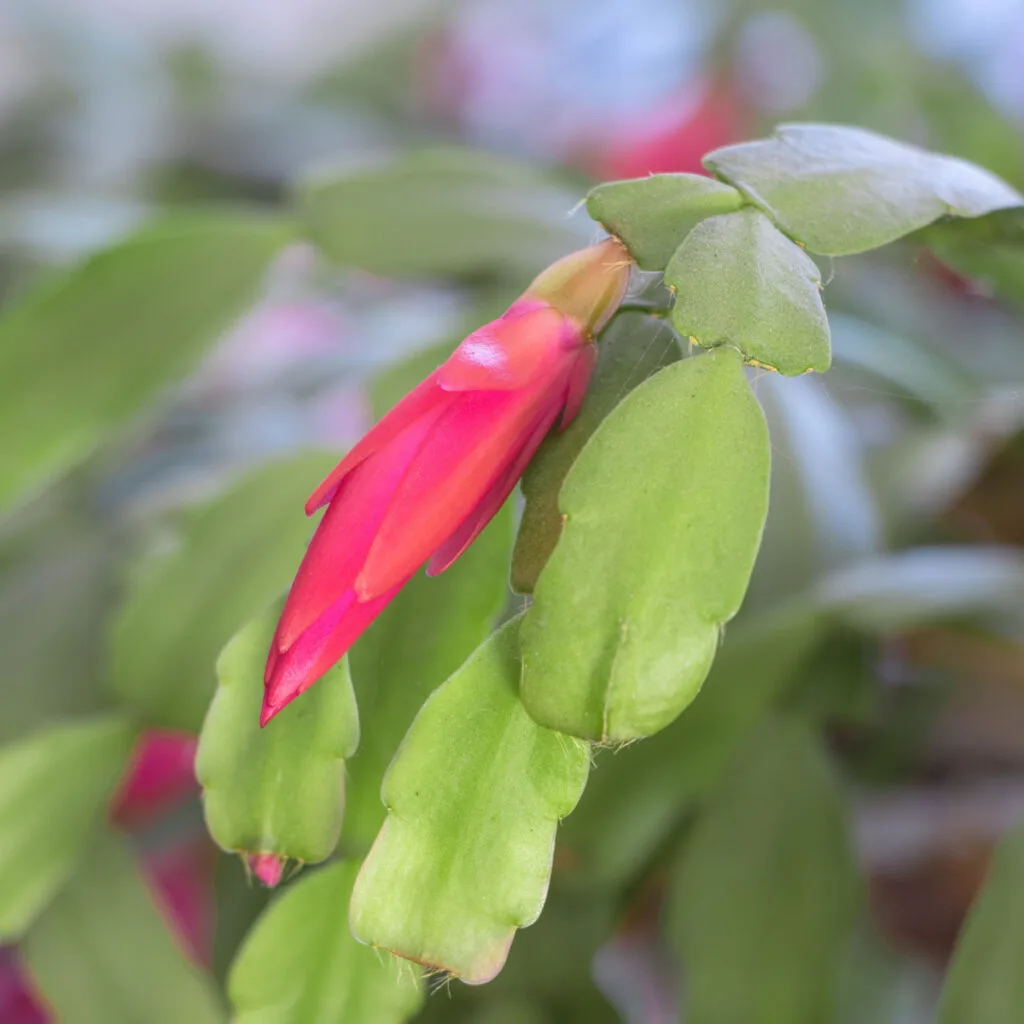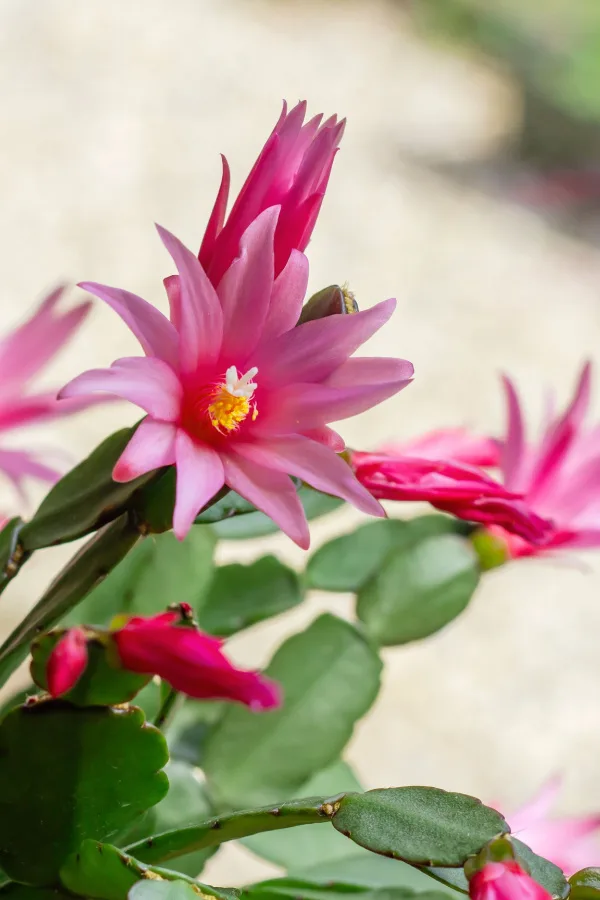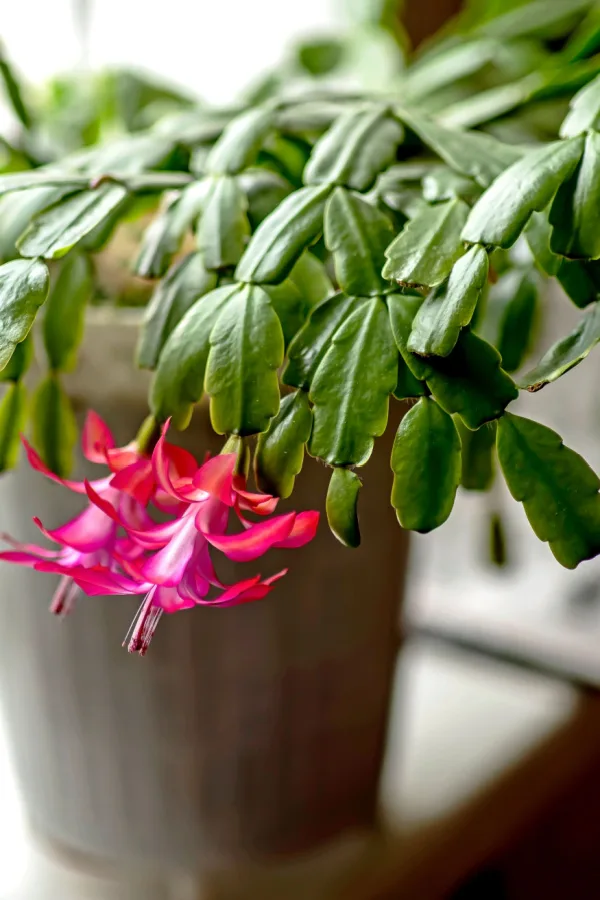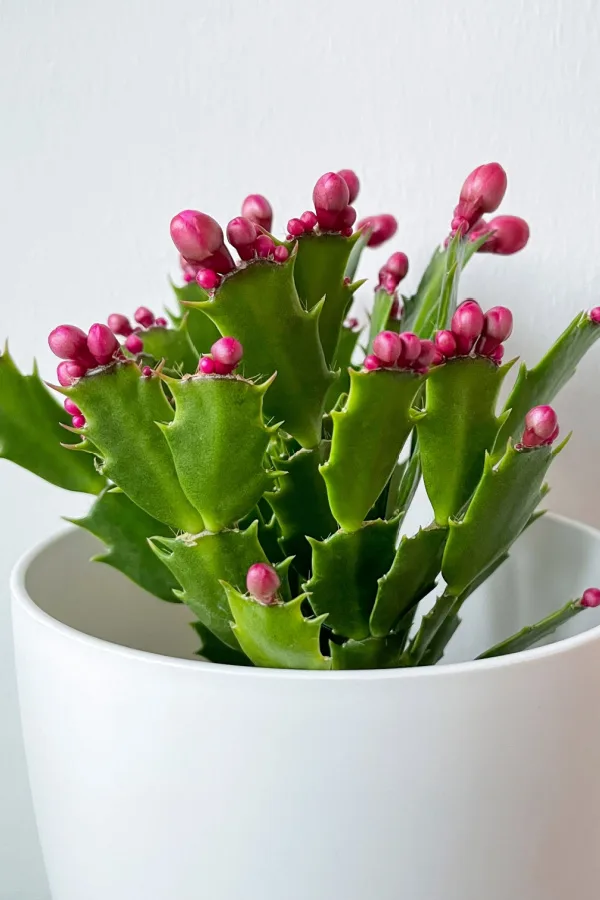Did you know that you can make your Christmas cactus bloom again for a second time after the holiday season has come and gone?
It’s true! No matter if you are growing a Thanksgiving cactus or a Christmas cactus, with just a bit of additional care, you can get them to bloom again for a second time after they finish their first flush of blooms.
Let’s face it, during the winter, there aren’t many plants that produce beautiful blooms. Especially when it comes to flowering just in time for the holiday season. In fact, when it comes down to it, you really have only two choices for big color – the poinsettia plant and the Christmas cactus.

The poinsettia is certainly a prolific plant with big holiday flower power. But when its blooms begin to fade, the plant needs to be pruned back in order to regenerate and grow a new canopy of foliage.
While this occurs, the plant can be quite sparse – and it can take awhile to fill out with new foliage. Even more, there is zero chance of a quick re-bloom. See our article: How To Care For Poinsettia Plants After Christmas
The Joy Of Getting A Christmas Cactus To Bloom Again
The good news is that Christmas cacti (and Thanksgiving cacti as well) are different than poinsettia plants. With their draping green foliage, even when these long-living plants aren’t in bloom, they are still attractive foliage plants.
But let’s face it, it’s the stunning blooms of red, pink, white, orange and purple that really draw people to owning Christmas cactus plants. And that is exactly why getting a second bloom out of them can really make growing one even more exciting than ever.
While their overall care is fairly simple, there are a few steps that you need to take in order for Christmas cactus plants to push out a second set of vibrant blooms – and that is exactly what today’s article is all about!

How To Make A Christmas Cactus Bloom Again
Not All Holiday Cacti Are The Same
Whether you can get your holiday cactus to bloom a second time depends on the type of cactus you are growing. There are three main types of holiday cacti, and all three have different features, blooming times, and requirements.
The first is an Easter cactus. The Easter cactus is the least common of the three and only bloom in early spring. Easter cacti feature very round edges on the leaves. Their blooms are more starburst in shape with pointed tips.
A Thanksgiving cactus blooms in the late fall, right around their namesake holiday. Thanksgiving cacti feature sharper claw-like edges on the leaves that are fairly distinctive from the other two varieties. Their blooms are more tubular in shape.
Christmas cactus plants bloom right around the Christmas holiday time frame. Their leaves are more tear-drop shaped and have scalloped edges. Their blooms though are very similar to those of the Thanksgiving cactus. Because of this, the two are quite often mistaken for one another.

All three varieties are short-day plants that require a long period of darkness (14+ hours) in order to set blooms. Both Thanksgiving and Christmas cacti need around 6 to 8 weeks of total darkness and Easter cacti require more around 8 to 12 weeks of darkness.
But, and this is important when trying to get a holiday cactus to bloom again – only the Thanksgiving and Christmas cacti are capable of blooming a second time each year. So if you happen to own an Easter cactus, no matter how hard you try, one blooming period per year is all you will be able to get.
Getting A Christmas Cactus To Bloom Again
In order to know how to get a Christmas (or Thanksgiving) cactus to bloom again, it’s important to first know how it is forced into flowering for its first blooming session during the holidays.
If you just purchased your Christmas cactus this year, it’s likely that it already had buds on the ends of the stems. This is because the nursery or grower took the steps to “force” the cactus into bloom prior to the plant heading to the store.
So how are these plants made to bloom? About 10 weeks before the holiday season begins, the Christmas cactus is moved to a cool location that is around 50-55º F. In addition, the cactus is kept dark for most of each day, getting at least 14+ hours of complete darkness during this time frame.
About two weeks before they want it to start forming blooms, they then bring the cactus out to a warmer location. It is at that point that the flowering buds will form on the tips of the leaves. And then, those same buds open just in time for the holiday season.

During its first blooming period, a Christmas cactus will keep flowering for around 4 to 6 weeks. But at the end of its first bloom period – by simply repeating the same steps that helped the plant form its first set of blooms, you can make the cactus develop another bloom set to flower a second time.
“Forcing” A Second Bloom
If you want to force a second bloom, you need to expose your plants to short-day conditions once again. To do this, you need to wait until the plant is completely done blooming the first time. Then, move the plant back to a cool location (between 50 and 55°F) for four to six weeks. A cool, dark basement is usually perfect for this.
Be sure that the plant gets at least 14+ hours of complete darkness every single day. Beyond the dark period, expose the cacti to bright, indirect sunlight for the remaining 8 to 10 daylight hours each day. Do not place it in a sunny window, but nearby where it can get indirect light from the window.
For this time period of light, if you do not have a bright enough room, consider using a grow light to help. During this process, water the plant as you normally would.
After about four weeks, you should start to see buds form on the tips of the stems. Once you see buds, you can then move the plant back to its warmer location. And just like during the first bloom period, within a few weeks, the cactus will be flowering once again.

It’s important to note that the second flush of blooms will not be as prolific as the first. This is due to the plant already having used up a fair amount of energy for the first set of flowers. But with that said – the second flowering is still quite impressive to behold!
Caring For A Christmas Cactus After It Blooms Again
After your Christmas or Thanksgiving cactus blooms a second time, it is ready for some rest! Although a second bloom is possible, trying to force any more can be detrimental to the plant’s long term health.
In indoor settings, Christmas cacti need regular watering. They also need to grow in a more humid than dry area. Last but not least, they also require bright but indirect sunlight. If leaves start to turn a reddish-purple color, it is an indication the plant is receiving too much direct sunlight.
Although not necessary, you can keep Christmas cactus plants outdoors in a shady location during the spring and summer months. However, when temperatures drop below 50º Fahrenheit (F), it’s time to move the plant inside.
Christmas cactus plants need to have consistent water but it’s important to avoid overwatering. Wait until the top third of the soil is dry before watering. Water thoroughly and allow any excess water to completely drain out of the container.

You will want to fertilize your Christmas cactus plants once a month in the spring and summer months. To do so, it’s best to use a liquid all-purpose indoor plant fertilizer. (Affiliate Link: Indoor Liquid All-Purpose Plant Food)
Be careful not to use fertilizers designed for cactus or succulent plants since these are tropical cacti. Stop all fertilizing in late summer before fall arrives. Here is to enjoying your Christmas cactus blooming not once this year – but twice! For more Christmas cactus care tips, see: The 3 Biggest Mistakes That Ruin Christmas Cactus Blooms – And How To Avoid Them!
Simple Garden Life
Follow Our Facebook Page For Even More Great Tips! Simple Garden Life Facebook Page
Simple Garden Life is a website dedicated to keeping gardening fun, simple and enjoyable! We publish two new articles each week along with a new garden podcast episode every two weeks. This article may contain affiliate links.
